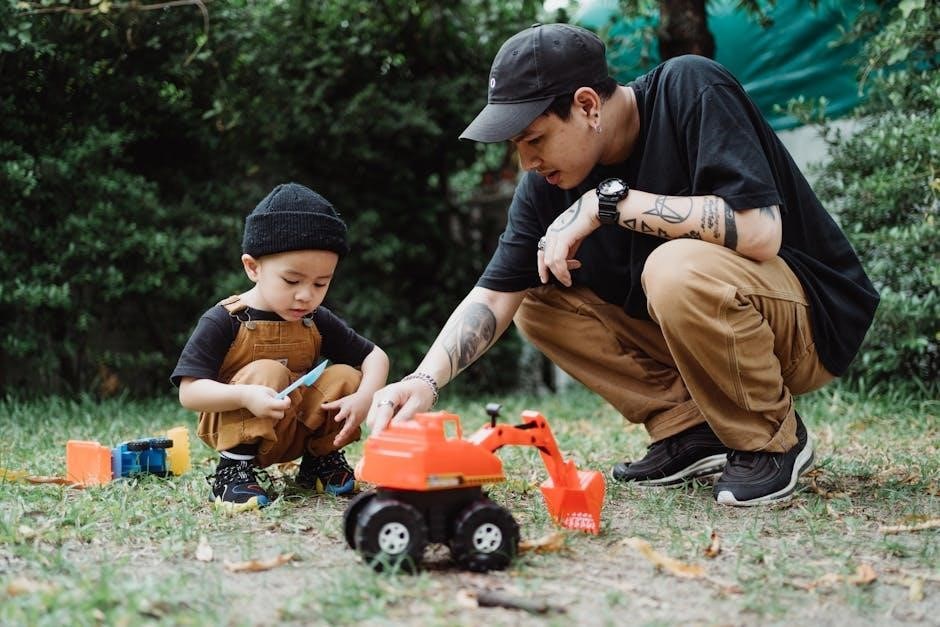This guide helps parents understand the themes, content, and suitability of Ghost in the Shell for children, addressing violence, nudity, and complex philosophical ideas present in the film.
What is Ghost in the Shell?
Ghost in the Shell is a thought-provoking science fiction film based on the renowned manga by Masamune Shirow. The story revolves around Major Motoko Kusanagi, a cyborg policewoman grappling with existential questions about her identity and humanity. Set in a futuristic world where technology and biology converge, the film explores themes of self-discovery, ethics, and the implications of cybernetic enhancements. The 2017 adaptation, starring Scarlett Johansson, brings to life the iconic tale of a woman awakening in a cybernetic body, devoid of memories, and her quest to uncover the truth about her past. Known for its visually stunning depiction of a cyberpunk universe, the movie delves into complex philosophical ideas, making it a compelling yet intense experience for viewers. Both the 1995 anime and 2017 live-action versions have garnered acclaim for their deep narrative and futuristic visuals.
Why Parents Need a Guide for This Movie
Parents need a guide for Ghost in the Shell due to its mature themes and content, which may not be suitable for all ages. The film contains mild nudity, moderate violence, and intense scenes that could be unsettling for younger viewers. Additionally, it explores complex philosophical questions about identity and existentialism, which may require parental guidance to help children understand. The movie also delves into ethical dilemmas related to technology and humanity, making it essential for parents to assess whether their child is emotionally and intellectually prepared for such themes. The guide helps parents make informed decisions about whether the film is appropriate for their child and provides insights into discussing its deeper concepts with them. This ensures a thoughtful and age-appropriate viewing experience for children.
Content Ratings for Parents
Ghost in the Shell has mild sex/nudity, moderate violence/gore, mild profanity, and some alcohol/drug content, making it essential for parents to evaluate its suitability for younger audiences.
Violence and Gore in the Movie
Ghost in the Shell contains moderate violence, including action sequences, explosions, and combat. While there are intense moments, the gore is not excessively graphic. The film features futuristic combat, cybernetic enhancements, and some scenes of destruction. Parents should be aware of the movie’s action-oriented nature, which may include characters being injured or destroyed, though these scenes are often stylized rather than gruesomely realistic. The violence is primarily used to advance the plot or emphasize the stakes, rather than for shock value. However, younger or sensitive viewers may find certain scenes unsettling due to the intensity and futuristic weaponry. Overall, the violence aligns with the film’s sci-fi and action genres, but it’s important for parents to assess their child’s sensitivity to such content.
Sex and Nudity Scenes Explained
Ghost in the Shell contains mild sexual content and nudity, primarily in the form of the protagonist’s cybernetic body. Major Motoko Kusanagi wears a skin-colored suit that outlines her body, creating a semi-nude appearance. While this could raise concerns, the nudity is not sexualized but rather anatomical and futuristic in nature. There are no explicit sexual scenes or graphic content. The film focuses more on philosophical themes than on exploiting the character’s form. Parents should be aware of these scenes, but they are not overly explicit or prolonged. The movie’s approach to nudity is more about exploring identity and technology than titillation. Overall, while some scenes may warrant discussion, they do not dominate the film’s narrative or intent.
Profanity and Language Used
The language in Ghost in the Shell is generally mild, with occasional use of profanity. While not excessive, some scenes may include expletives or intense dialogue that could be of concern for younger audiences. The film’s futuristic setting often prioritizes philosophical discussions over casual swearing, but parents should still be mindful of the tone and context in which such language is used. The focus remains more on storytelling and thematic depth rather than relying on strong language for effect. Overall, the profanity is not a dominant feature of the movie, making it relatively moderate in this regard. Parents reviewing the film for younger viewers may want to preview scenes with stronger language to assess suitability based on their child’s sensitivity to such content.
Alcohol, Drugs, and Smoking Content
In Ghost in the Shell, content related to alcohol, drugs, and smoking is minimal and not a major focus of the film. There are brief scenes where characters engage in smoking or consume alcohol, often in the context of social or professional settings. These portrayals are not glorified but rather serve to add depth to the characters or the dystopian environment. Drugs are rarely mentioned or shown, and their depiction is not central to the storyline. The overall emphasis remains on the film’s philosophical and action-driven narrative, with substance use being a secondary element. Parents should be aware of these elements, though they are not overly prominent or explicit. The film’s focus on cybernetic themes and existential questions overshadows any minor references to alcohol or smoking, making such content relatively mild compared to other aspects of the movie.
Frightening and Intense Scenes
Ghost in the Shell contains several scenes that may be unsettling for younger viewers. The film features intense action sequences, including hand-to-hand combat and futuristic weaponry, which could be disturbing. Some scenes involve the protagonist, Major Motoko Kusanagi, experiencing glitches or physical harm, which might be frightening due to their visual and emotional impact. Additionally, the exploration of existential themes and identity crises adds a layer of psychological intensity. While the movie avoids excessive gore, the cybernetic enhancements and graphic representations of injuries could be alarming for sensitive audiences. Parents should consider their child’s sensitivity to such content, as the film’s dark and philosophical tone, combined with its visually striking but sometimes unsettling imagery, may not be suitable for all younger viewers.

Mature Themes and Symbolism
Ghost in the Shell explores complex themes like existential questions, identity, and humanity’s relationship with technology, making it a thought-provoking yet mature experience for young viewers.
Existential Questions and Philosophy
Ghost in the Shell delves into profound philosophical themes, prompting viewers to reflect on the nature of self and consciousness. The film explores existential questions through Major Kusanagi’s journey, as she grapples with her identity and humanity in a cybernetic body. These themes encourage deep thought about what defines human existence beyond physical form.
Parents should be aware that the movie’s philosophical undertones may resonate more with older audiences, as younger viewers might find these concepts complex. The film’s portrayal of a protagonist questioning her reality can spark meaningful discussions about self-discovery and the ethical implications of technology. While these themes are not inherently inappropriate, they may require context and guidance for younger viewers to fully understand and process.
Identity Issues and Self-Discovery
Ghost in the Shell explores themes of identity and self-discovery, particularly through Major Kusanagi’s journey. The film delves into her struggle to reconcile her humanity with her cybernetic body, raising questions about what defines selfhood. This narrative arc is central to the story, as Kusanagi grapples with her existence and the nature of her consciousness.
For parents, this theme may prompt discussions about self-identity and the impact of technology on human experience. While the movie’s philosophical depth is thought-provoking, younger viewers might find it challenging to fully grasp these complex ideas. The portrayal of Kusanagi’s search for her past and her sense of self can spark conversations about personal identity and belonging, making it a valuable topic for parental guidance and reflection.
Ethical Dilemmas in Technology
Ghost in the Shell delves into significant ethical dilemmas surrounding technology, particularly in its portrayal of cybernetic enhancements and artificial intelligence. The film raises questions about the limits of technological advancement and its impact on humanity. Themes such as consciousness, free will, and the fusion of human and machine are central to the narrative, challenging viewers to consider the moral implications of such advancements.
Parents should be aware that the movie explores complex issues like the manipulation of memories and the potential for technology to control or exploit individuals. These themes may encourage discussions about the responsible use of technology and the importance of maintaining human values in a rapidly evolving world. The film’s exploration of these ethical dilemmas makes it a thought-provoking resource for families to examine together.

Visual and Special Effects
The film’s stunning visuals and special effects create a futuristic world with cybernetic bodies and immersive environments, enhancing the storytelling and themes of humanity and technology integration.
How the Movie’s Visuals Might Affect Children
The movie’s visuals, while visually stunning, may be overwhelming for younger viewers due to their futuristic and sometimes unsettling nature. The cybernetic bodies and intense action sequences could be disturbing to children who may not fully understand the context or themes. The film’s dark and complex imagery, including scenes of violence and mild nudity, may require parental guidance to help children process the content appropriately. Additionally, the exploration of identity through visuals, such as the protagonist’s cybernetic form, might spark questions about humanity and technology that younger audiences may find challenging to grasp. Parents should consider their child’s sensitivity and maturity level before allowing them to watch, ensuring they are prepared to discuss the film’s deeper and potentially confusing elements.
The Role of Cybernetic Bodies in the Story
Cybernetic bodies play a central role in Ghost in the Shell, exploring themes of identity and humanity. The protagonist, Major Motoko Kusanagi, exists in a cybernetic body, raising questions about what defines self. This concept is crucial for parents to discuss with children, as it delves into existential ideas. The film portrays cybernetic enhancements as both empowering and alienating, highlighting ethical dilemmas. While these themes are complex, they offer opportunities for meaningful conversations about technology’s impact on society. Parents should guide children in understanding the balance between technological advancement and human emotion, ensuring they grasp the story’s deeper philosophical layers. This element is vital for helping young viewers critically analyze the film’s narrative and its implications on personal identity.

Character Analysis for Parents
This section examines the main characters in Ghost in the Shell, focusing on their development and roles. It highlights their motivations and how they contribute to the story’s themes, aiding parents in understanding character dynamics and their potential impact on young viewers.
Major Motoko Kusanagi: The Protagonist
Major Motoko Kusanagi is the central character, a cybernetically enhanced officer grappling with existential questions about her identity and humanity. Her journey explores self-discovery and the ethics of technology, making her a complex figure for young audiences. Parents should be aware of her nuanced portrayal, which delves into deep philosophical themes and emotional intensity. While her resilience and courage are admirable, her struggle with her cybernetic body may prompt discussions about body image and self-acceptance. The film’s focus on her internal conflict highlights her role as a symbol of identity and existential inquiry, which may resonate differently with children versus adults. This analysis helps parents guide conversations about her character and its implications.
Supporting Characters and Their Roles
The supporting characters in Ghost in the Shell play pivotal roles in shaping the narrative and assisting Major Kusanagi. Batou, a loyal colleague, brings emotional depth and camaraderie, while the Puppet Master represents philosophical and technological conflict. These characters enhance the story’s complexity, offering insights into themes like identity and ethics. Parents should note that interactions between characters often involve intense dialogue and moral dilemmas, which may require discussion with younger viewers. The dynamics between Kusanagi and her team highlight loyalty and trust, emphasizing positive values. However, some characters’ motivations and actions, particularly the Puppet Master’s, might raise questions about morality and technology’s consequences. Understanding these roles helps parents guide conversations about the film’s deeper themes and their relevance to children. The supporting cast enriches the story, making it a layered experience for audiences.

Suitable Age Recommendations
Ghost in the Shell is rated for mature audiences due to complex themes, violence, and some nudity. It is generally recommended for viewers aged 16 and above, depending on individual sensitivity and maturity levels.
Recommended Age by Different Rating Systems
Different rating systems provide varying age recommendations for Ghost in the Shell. In the US, the 2017 version is rated PG-13 for violence, suggestive content, and some disturbing images. The 1995 anime is unrated but contains mature themes, nudity, and intense scenes, suggesting it is inappropriate for younger audiences. International ratings, such as the UK’s 15 certificate, align with these guidelines, restricting the film to viewers aged 15 and above. In Japan, the original anime is rated R15, indicating it is not suitable for minors under 15. These ratings reflect the film’s complex and mature content, emphasizing the need for parental discretion. While the live-action version is slightly more accessible, both iterations are best suited for teenagers and adults due to their thematic depth and visual intensity.
Factors to Consider for Younger Viewers
When deciding if Ghost in the Shell is suitable for younger viewers, parents should consider the film’s mature themes, visual intensity, and emotional depth. The movie explores complex ideas like existential questions and identity, which may be challenging for younger audiences to fully grasp. Additionally, the cybernetic bodies and futuristic setting might be unsettling for some children. While the film is visually stunning, its philosophical undertones and introspective tone may not appeal to younger viewers. Parents should also be mindful of the film’s rating and content, as it contains scenes that could be too intense or confusing for children. Ultimately, the decision should be based on the child’s maturity level and sensitivity to such themes. It is essential to use discretion, as the film is primarily geared toward older audiences;

Positive Messages in the Movie
The film emphasizes themes of resilience, courage, and self-discovery, highlighting the importance of teamwork and loyalty. It encourages viewers to reflect on identity and humanity’s deeper values.
Themes of Resilience and Courage
Ghost in the Shell highlights resilience and courage through Major Motoko Kusanagi’s journey. Her struggles with identity and existence showcase strength in adversity, inspiring reflection on self-discovery and purpose.
Importance of Teamwork and Loyalty
The film emphasizes the significance of teamwork and loyalty through Section 9’s unity. Major Kusanagi and her team consistently demonstrate trust and cooperation, underscoring the value of camaraderie in overcoming challenges.
Comparisons with Other Versions
This section explores how the 2017 film adapts themes from the 1995 anime and manga, highlighting differences in storytelling, visuals, and character development for parental consideration.
Differences Between the 1995 and 2017 Versions
The 1995 anime focuses heavily on philosophical themes and existential questions, with a slower-paced, more introspective narrative. In contrast, the 2017 live-action film emphasizes action and visual spectacle, offering a more straightforward storyline. While both explore the identity of Major Motoko Kusanagi, the live-action version delves deeper into her backstory and humanity. The anime features more abstract and symbolic scenes, particularly in its depiction of the Puppet Master, while the 2017 film opts for a more grounded, realistic approach. Parents should note that the live-action version has more intense violence and some nudity, though not sexual in nature, whereas the anime’s content is more cerebral but still contains some graphic elements. These differences impact the suitability for younger audiences, with the live-action film potentially being more accessible but also more visually intense.
How the Manga Compares to the Movie
The original manga by Masamune Shirow serves as the foundation for both the 1995 anime and 2017 live-action film, but each adaptation diverges in storytelling and tone. The manga explores themes of cybernetic enhancements and existentialism in depth, offering a complex narrative with philosophical undertones. It delves into the ethics of technology and identity through Major Motoko Kusanagi’s journey, featuring detailed artwork that enhances the story’s atmospheric and introspective qualities. While the movies simplify some plot elements for broader audiences, the manga retains its intricate and layered storytelling, making it a richer source for exploring the franchise’s core themes. Parents should be aware that the manga contains some violence and mature themes, similar to the films, but its dense narrative may appeal more to older, intellectually curious readers.
Ghost in the Shell is a thought-provoking film that explores complex themes, making it essential for parents to assess its suitability for their children based on maturity and sensitivity levels.
Final Thoughts for Parents
While Ghost in the Shell offers a compelling narrative and stunning visuals, parents should carefully consider their child’s sensitivity to violence, nudity, and philosophical themes. The film’s complex exploration of identity and ethics may resonate more with mature audiences. It’s crucial to evaluate whether your child can grasp the deeper meanings without being disturbed by the content. Open discussions after viewing can help address any concerns and enhance understanding. Ultimately, the decision to allow your child to watch depends on their individual maturity and your family’s values;
Should Your Child Watch Ghost in the Shell?
Deciding whether your child should watch Ghost in the Shell depends on their age, maturity, and sensitivity to certain themes. The film contains moderate violence, some nudity, and explores complex philosophical ideas. Children under 13 may find the content unsettling due to intense scenes and deep existential questions. Older teens, however, may appreciate the film’s intellectual depth and visual appeal. Parents are encouraged to preview the movie to assess its suitability for their child. Open conversations afterward can help clarify themes and address any concerns. Ultimately, it’s a film that can spark meaningful discussions but should be viewed with caution for younger audiences.
